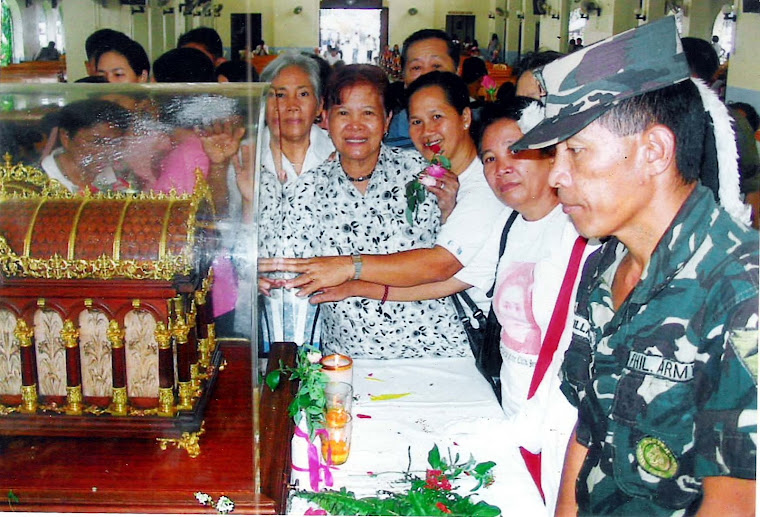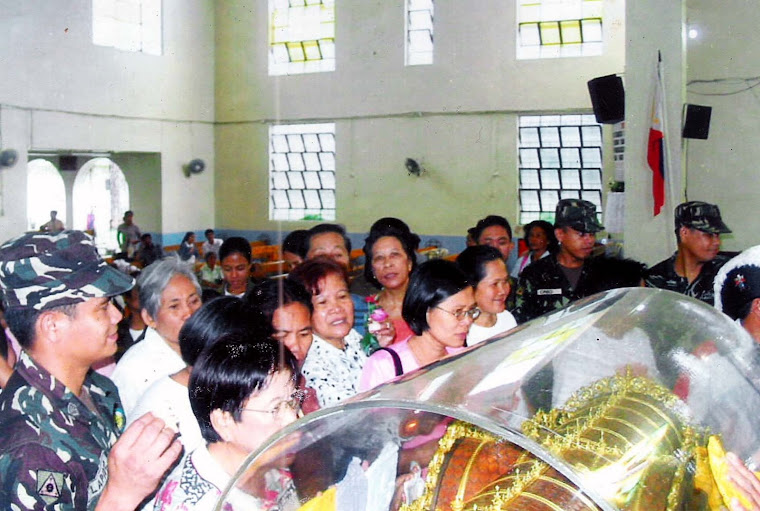The Parish of Saint Francis Xavier is requesting the parishioners to lend a home for the participants of the Regional Youth Days.
Friday, April 17, 2009
Regional Youth Day
Monday, April 13, 2009
Biblical Reflections for Easter Sunday

Biblical Reflections for Easter Sunday
By Father Thomas Rosica, CSB
TORONTO, APRIL 8, 2009 (Zenit.org).- Easter is the promise that death will visit each of us. But more important, it is the assurance that death is not the last word. The Resurrection of Jesus prompts us to recall, from the darkest moments of grief to life's smallest trials, how much God comforts us and gives us the strength to persevere. The Easter mysteries give us a new identity and a new name: we are saved, redeemed, renewed; we are Christian, and we have no more need for fear or despair.
Through the powerful Scripture readings of the Triduum, and especially the Gospels of the Easter Vigil and Easter morning, we catch glimpses of just what resurrection means. How can we give expression to the conquest of death and the harrowing of hell? We must honestly admit to ourselves that there are no words. Therefore we turn to the experiences of the women at the tomb in Mark's Resurrection account and to Mary Magdalene, witness of the Risen Lord, to find images and words to describe what has happened.
The Silence of the Women
Mark's Gospel text for the Easter Vigil [16:1-8] leaves us more than perplexed. We read that after discovering Jesus' tomb to be open and empty and hearing the angelic message about the resurrection and a future meeting with him in Galilee, the women "went out and fled from the tomb, for terror and amazement had seized them; and they said nothing to anyone, for they were afraid."
Is it possible that Mark's Gospel can really end with 16:8? Early Christian editors, puzzled by such a shocking ending, supplied two more conventional endings for the Gospel; the longer of these is printed in most bibles as Mark 16:9-20. Nevertheless, the question lingers: What can we say about a resurrection story in which the risen Jesus, himself never appears? How could Mark differ so much from Luke's masterful resurrection chapter [24] or John's highly developed portraits of the first witnesses of the resurrection [20-21]?
Rather than dismiss the strangeness of Mark's ending, let us reflect carefully on what Mark's Gospel offers us. First of all, we never see the Risen Jesus, himself. We are offered instead a rather haunting scene. It early morning, still dark, and the women arrive at the tomb for a near impossible task. The tomb is already opened and they are greeted by someone from heaven who commissions them: "Go and tell his disciples and Peter that he goes before you into Galilee; there you will see him as he told you." [16:7]
The fear and trembling that accompanies the women prevents them from telling anyone about what they have seen. Of what are they afraid? By remaining silent, are they disobeying the message of the angel to "Go and tell…?" What are we to make of the silence of the women?
Mark's resurrection story contains an initial declaration and summary statement of all of Jesus' teaching in the Gospel: "Do not be alarmed!" [16:6]. The reader is told to abandon every fear. Second, the reader is told: "you are looking for Jesus of Nazareth, who was crucified. He has been raised; he is not here. Look, there is the place they laid him" [16:6].
The crucifixion of the Lord Jesus was not the final, definitive moment of his life. As Christians, our faith is not placed in a crucified, dead man, nor in an empty tomb, but in a risen, living Lord who lives among us with a whole new type of presence. "He is going ahead of you to Galilee; there you will see him, just as he told you" [16:7]. The message of the resurrection in Mark's Gospel is given to us. The event is simply too great to be presented with meager words!
Mark's resurrection account is constructed to unsettle us–to undo the ease that makes us forget that the call to discipleship is the call to the cross. Throughout the entire Gospel, we are invited to view our lives in the shadow of the cross.
The women go to the tomb, drawn unconsciously by the powerful and enticing mystery of God about to be revealed to them. They flee from the tomb [16:8] shocked by the awesome message of Jesus' resurrection. Faced with this rather incredible news of the resurrection of the crucified Jesus, the silent and fearful flight of the women is not only understandable but also highly appropriate.
Is it not also the same for you and for me? When faced with the awesome power of God at work in our lives, raising those dead parts back to life and restoring our dashed hopes and crushed spirits, a response of silence and fear, wonder and awe, is also understandable and at times appropriate –even for us.
The Witness of Mary Magdalene
Mary Magdalene, Mary of Bethany (sister of Martha and Lazarus), and the unnamed penitent woman who anointed Jesus' feet (Luke 7:36-48) are sometimes understood to be the same woman. From this, plus the statement that Jesus had cast seven demons out of Mary Magdalene (Luke 8:2), has risen the tradition that Mary Magdalene had been a prostitute before she met Jesus. But in reality we know nothing about her sins or weaknesses. They could have been inexplicable physical disease, mental illness, or anything that prevented her from wholeness in mind and body.
Mary Magdalene is mentioned in the Gospels as being among the women of Galilee who followed Jesus and His disciples, ministered to him, and who, according to each of the evangelists, was present at His crucifixion and burial, and went to the tomb on Easter Sunday to anoint His body.
Jesus lived in an androcentric society. Women were property, first of their fathers, then of their husbands; they did not have the right to testify; they could not study the Torah. In this restricting atmosphere, Jesus acted without animosity, accepting women, honoring them, respecting them, and treasuring their friendship. He journeyed with them, touched and cured them, loved them and allowed them to love him.
In our Easter Sunday Gospel [John 20 :1-18], we peer once again into the early morning scene of sadness as Mary Magdalene weeps uncontrollably at the grave of her friend, Jesus. We hear anew their conversation: "Woman, why are you weeping? Whom are you seeking?" "…Sir, if you have carried Him away, tell me where you have laid Him, and I will take Him away." Jesus said to her, "Mary!" She turned and said to Him in Hebrew, "Rabbouni!" (which means, Teacher). ... "Stop clinging to Me, for I have not yet ascended to the Father; but go to My brethren and say to them, 'I ascend to My Father and your Father, and My God and your God.'" Mary Magdalene came, announcing to the disciples, "I have seen the Lord," and that He had said these things to her. (John 20:15-18)
Because of her incredible message and mission, Mary Magdalene was fittingly called "Apostola Apostolorum" (Apostle to the Apostles) in the early Church because she was the first to see the Risen Lord, and to announce His Resurrection to the other apostles.
For Jesus, women were equally as able as men to penetrate the great religious truths, live them and announce them to others. There is no secret code about this story, which is still astonishingly good news more than 2,000 years later. Alleluia, Alleluia, Alleluia!
[The readings for Easter Sunday are Acts 10:34a, 37-43; Colossians 3:1-4 or 1 Corinthians 5:6b-8; John 20:1-9 or Mark 16:1-7 or Luke 24:13-35]
http://www.misyononline.com/misyonforum/index.php?q=node/820
Wednesday, April 1, 2009
Palm Sunday, April 5, 2009

In many Christian churches, Palm Sunday is marked by the distribution of palm leaves (often tied into crosses) to the assembled worshipers. The difficulty of procuring palms for that day's ceremonies in unfavorable climates for palms led to the substitution of boughs of box, yew, willow or other native trees. The Sunday was often designated by the names of these trees, as Yew Sunday or by the general term Branch Sunday.
According to the Gospels, before entering Jerusalem, Jesus was staying at Bethany and Bethphage, and the Gospel of John adds that he had dinner with Lazarus, and his sisters Mary and Martha. While there, Jesus is described by the Synoptic Gospels as sending two unnamed disciples to the village over against them, in order to retrieve a colt that had been tied up but never been ridden, and to say, if questioned, that the colt was needed by the Lord but would be returned in a short period of time. Jesus then rode the colt into Jerusalem, with the Synoptics adding that the disciples had first put their cloaks on it, so as to make it more comfortable. The Gospels go on to describe how Jesus rode into Jerusalem, and how the people there lay down their cloaks in front of him, and also lay down small branches of trees. The people are also described as singing part of Psalm 118 - ...Blessed is He who comes in the name of the Lord. Blessed is the coming kingdom of our father, David. ... (Psalms 118:25-26). Where this entry is supposed to have taken place is unspecified; some scholars argue that the Golden Gate is the likely location, since that was where it was believed the Jewish messiah would enter Jerusalem; other scholars think that an entrance to the south, which had stairs leading directly to the Temple, would be more likely (Kilgallen 210). According to Jewish tradition (Sefer ha Zohar, part about donkey driver) the one who is able to bridle and ride a colt (or donkey) has a status of Messiah.






















